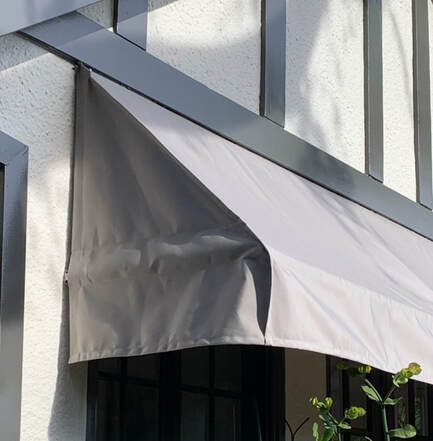Awning frames that use pipes can actually cost you more in the long run. However, pipe frames cut out the need for a welder which means fabrication costs can be cheaper. This may seem like a good idea at the time, but this does create problems with the awning down the road.
Here are some drawbacks to pipe frames you should know:
- Oftentimes the fabric supports the pipe frame to maintain the shape of the awning which puts stress on awning fabric and seams. That means your fabric can come off the frame or its seams can tear off, costing you more money in repairs.
- Fabric can’t be stretched as tightly on these frames and that means:
– The fabric will look loose, making your awning look worn or old. - – Rainwater and dirt can collect more easily as the fabric droops and creates a pooling area.
- If you need to replace the fabric on a pipe frame awning, it will take much more time and cost you more, thus the value of a pipe frame awning is actually worse for the owner in the long run.
- Today, many of these pipe frame awnings wouldn’t pass building codes because they are not welded, the fabric can come off more easily, and so much more.
- In some of the older pipe frame awnings, only portions of the awnings were framed out with pipe and other portions would hang loosely.
As you can see, pipe frame awnings, while they were all the rage a few decades ago, are actually not great investments and should be replaced. Your awning should look professional and its frame should be strong, welded together instead of using fittings which can come loose over time. The fabric of your awning should also be taut, not loose. If your business or restaurant awning has loose fabric, this detracts from the professional look and feel of your building.
A welded awning frame offers stability and a pleasing aesthetic. (Keep in mind schedule 40 pipe doesn’t always look the best). Welded frames also give you peace of mind in that they are reliable, sturdy, and don’t snap or break apart in heavy winds or rains. So, what are some upsides to replacing a pipe frame with a new welded frame?
Here are the benefits of a welded awning frame:
- The fabric of the awning will look tight, professional, and will look cleaner and nicer.
- The fabric will last longer and thus cost you less in the long run. The fabric won’t be loose on the frame and won’t collect as much rainwater or dirt because it’s not drooping.
- If you want to replace the fabric on the frame, it’s much easier and thus will cost you less.
- Welded frames are up to building code standards and you don’t have to worry that a fitting or thread will come loose.
Now that you know why installing a welded frame awning is a better option, consider replacing your pipe frame today. At American Awning and Blind Co. we help you choose the right welded frame awning. We’re an all-in-one awning company; from design, permitting, architectural rendering, and more, we help you every step of the way. Contact us today for your free consultation.
Visit us online at American Awning & Blind Co. at http://americanawningabc.com. (Our California Contractors License is #999050). Or give us a call at 800-654-5933. You can also email us at info@americanawningabc.com.

